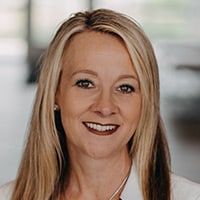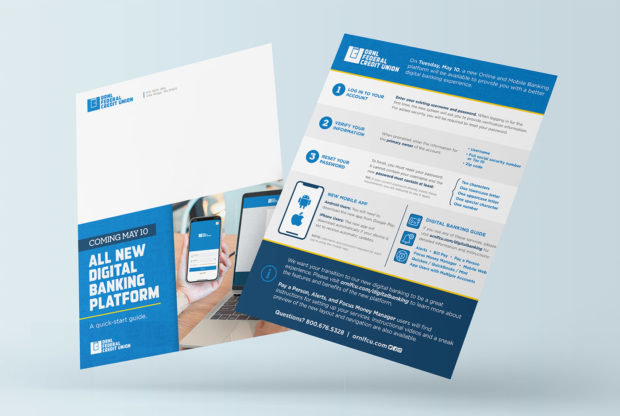Leaders at ORNL Federal Credit Union felt they had at least one good reason to pursue a digital banking conversion. Members occasionally had problems logging into their accounts, and they were not shy about sharing their frustration.
“Downtime is not okay in a digital banking environment,” says Dawn Brummett, chief operating officer at the $3.1 billion-asset credit union in Oak Ridge, Tenn.
In 2021, the credit union decided to switch to a new provider and upgrade the digital experience for its 190,000 members, of which 109,000 were banking online or via the mobile app at the time.
It had several key goals, including eliminating the downtime that too often prevented access to digital banking and adding a dedicated platform for business customers, who were using a system designed primarily for retail customers.
ORNL also wanted a faster way to introduce digital upgrades, Brummett says. Upgrades were commonly taking at least four months.
“In our shop, that’s more like a project, not an upgrade,” says Brummett, who declined to name the credit union’s former provider. “They were just the wrong fit for us.”

Navigating the Role of AI in Financial Institutions
83% of FI leaders agree investing in AI is essential for 2024 but how you leverage AI is instrumental in success and meeting customer expectations.
Read More about Navigating the Role of AI in Financial Institutions

Move the Needle from Attrition to Acquisition
Vericast’s 2024 Financial TrendWatch explores seven of today’s most critical financial services trends to provide a complete view of the current loyalty landscape.
Read More about Move the Needle from Attrition to Acquisition
The Trouble with Digital Banking Conversions
Banks and credit unions are often reluctant to change their digital banking platform even when they’re dissatisfied.
One reason is that adopting a new system risks major disruptions for users, says Mohammad Nasar, a principal in the financial services consulting group at Crowe. People generally bristle at changes to the digital tools they know, and financial institutions tend to struggle to convey why change is needed.

Dawn Brummett, chief operating officer at ORNL Federal Credit Union
“I don’t think it’s something that’s particularly well-managed,” Nasar says of digital upgrades.
Financial institutions also may have trouble reacting to the feedback they hear during and after digital projects, he says. “Do we truly understand that this feedback is something that’s legitimately meaningful, or are people just complaining because it’s different?”
In the absence of strong data to help answer the question, institutions tend to over- or underreact, he says. And even if they collect the right data, they may not share it among business lines. “There are certainly opportunities for improvement in that regard,” Nasar says.
ORNL, however, appears to have carved a path that avoided many of the pitfalls associated with digital banking conversions. Brummett’s insight into what went right, and why, could help others set their own projects up for success.
‘V’ for Victory: A Sharp Rebound in Satisfaction Scores
The credit union’s new digital banking platform, provided by Alkami, went live in May 2022. But its leaders began laying the groundwork in October 2021. They cleaned up member data on their system, for example, and reviewed the resources available for the project.
ORNL’s strategy revolved around minimizing disruption to the user experience.
“We wanted our members to be able to get back into the digital app, conduct their business, and hopefully forgive us for the change,” Brummett says. Ideally, they’d even “be happy at the end of the day” about the improvements.
While there was a drop in member satisfaction following the digital conversion, it was short-lived. Satisfaction levels quickly rebounded, forming a “V” instead of the “U” shape that is common with such projects. The credit union’s net promoter score, or NPS, rose from a low of 64 immediately following the launch, to a 79.75 by August, according to a case study by Support EXP, a vendor that helped ORNL filter customer feedback. That’s a 25% boost in just three months. (The scale for the scoring ranges from -100 to 100.)
Allison Cerra, chief marketing officer at Alkami, says a U-shaped pattern is typical. She thinks ORNL’s preparation helped it recover more quickly, as did having Alkami employees on site when the digital conversion went live.
Brummett agrees with that assessment. She also attributes the sharp rebound in member satisfaction, in part, to the volume of resources thrown at the project. Employees across the credit union answered phones and manned the chat function to ensure prompt responses for members seeking help. Brummett herself even took member phone calls.
But she also recognized ahead of time that the call volume would be higher than ORNL could handle on its own. So the credit union contracted with PSCU, a credit union services organization, for additional assistance with member service in the wake of the system change.
Read more:
- Why Slips in Customer Service Are Especially Costly Right Now
- Core Issue: Plug-and-Play Is Transformative for Banks & Credit Unions

ORNL’s Call Center and In-App Chat Get Inundated
To ensure nothing was missed, credit union leaders centralized the collection and sharing of member feedback for the first three weeks after the new digital banking platform launched, Brummett says. A single team kept a log to track feedback and escalate responses if call center staff could not resolve an issue, Brummett says.
The team also monitored whether issues were new or repeating. If the team noticed patterns, it would send notices to branch and call center staff, arming them with information on how to help resolve those particular issues, Brummett says. “Our staff can get pretty fatigued during this type of conversion. So, it was really important that we kept them up to speed.”
In the two weeks following the launch, the credit union fielded roughly 36,000 calls, about the same number it typically gets in a four-week period, Brummett says. Volume started to decline after that, but was still up by 18% the following month. It returned to normal after three months.
An Influx of Inqueries:
In the two weeks following the digital banking conversion, ORNL fielded the same number of calls it typically gets in four weeks:36,000
Many of the questions had to do with usernames and passwords, which often had to be reset, Brummett says. Other questions came from members having trouble conducting transactions.
ORNL’s marketing and digital services team, meanwhile, monitored social media, email, app store comments and the in-app chat feature, whose usage spiked, Brummett says.
Before the launch of the new digital banking platform, less than 100 members per day communicated via the app’s chat feature. The volume rose to 500 per day afterward.
The number has since fallen, but many members appear to have stuck with the channel, Brummett says, noting there are about 250 chats per day now.
See all of our latest coverage of digital banking.

The unfair advantage for financial brands.
Offering aggressive financial marketing strategies custom-built for leaders looking to redefine industry norms and establish market dominance.

Navigating Credit Card Issuing in an Uncertain Economic Environment
Build a modern credit card strategy that balances profitability and risk, adopts the latest technology and delivers the customization that cardholders demand.
Read More about Navigating Credit Card Issuing in an Uncertain Economic Environment
What Worked Well in Managing the Digital Banking Conversion
Having Alkami employees on site during the launch to address issues with functionality made a “tremendous difference,” Brummett says.
For example, ORNL members got particularly hung up on a change to how they accessed the peer-to-peer payment function in the credit union’s mobile banking app. The button had moved, but many members simply clicked the button that replaced it, which was for ACH payments. With Alkami’s help, the credit union added a step that directed members to the right place.
“As soon as we loaded that in there, we saw a shift in the number of calls and issues that members were experiencing,” Brummett says.
In a digital banking conversion, bank and credit union leaders have to be able to recognize meaningful user feedback that requires action.
People sometimes complain because they just don’t like change, and reacting to every criticism would be a mistake, Alkami’s Cerra says. But when common themes emerge in the feedback, “that’s typically a signal that you probably need more education or training or that you need to react in a more meaningful way,” Cerra says.
Marshaling resources during the transition to the new digital banking platform also proved pivotal for ORNL.
When the number of daily chats soared, Brummett says, “Everyone in the credit union that could chat, that had that competency, was chatting and assisting members.”
“When we say ‘all hands on deck,’ it’s everyone across the credit union, whether you’re a member service employee or not.”
— Dawn Brummett, ORNL FCU
Another factor is that ORNL removed competing priorities for key employees. From the start of the process, the credit union cleared the calendar for those engaged in the conversion process and empowered them to push back if and when colleagues asked for help on other projects, according to Brummett.
“That was a big help,” she says. “It gave people permission to say, ‘I really have to focus on this right now. I’m happy to help you, but let’s wait until the digital conversion.'”
ORNL has 484 employees in all. Founded in 1948 to serve employees of Oak Ridge National Laboratory, the credit union now has a community charter with a field of membership spanning 19 counties in eastern Tennessee.
Go Heavy on Communication and Light on Rolling Out New Digital Features
For Brummett, lessons from the digital banking conversion include the importance of communicating with both members and employees.
Members, for example, appear to have benefited from a mailer designed by the marketing team.
The mailer, sent to members’ homes seven to 10 days ahead of the launch, focused on the steps to log in, the new features in the works and what else to expect from the digital overhaul. “It didn’t look like regular mail or junk mail and really got a lot of attention,” Brummett says.
ORNL also held back on some upgrades, saving them for later. “We couldn’t go into it with a seven-and-a-half month timeline and just throw out tons of brand new features to everyone,” Brummett says. “It wouldn’t have been successful.”
Features added since the launch of the new digital banking platform include a variety of self-serve options, she says. One is a limited Bitcoin offering for members who are interested in learning more about crypto and making investments. Members can invest up to $100,000 through the credit union’s app, which allows them to buy, sell and hold digital currencies.
Other new features include the ability to make member-to-member transfers; a one-click application to open a new account, such as a savings or money market account; a cleaner transaction display; and CardUpdatr, a third-party service that allows members to add their card to retail apps.
Read more:
- The Top 15 Features People Want in Their Mobile Banking App
- Four Ways Branch Self-Service Improves CX and Reduces Costs

What’s Ahead at ORNL: Digital Account Opening and More
Next, the credit union plans to add a self-serve option for its skip-a-payment feature, primarily used on auto loans, Brummett says.
Looking ahead to 2024, it expects to make additional changes, such as updating its digital account opening. The service is currently available for both new and existing members but it requires some manual intervention by staff, Brummett says.
In the meantime, the number of digital banking users at ORNL jumped to about 119,300 as of February. That’s a 9% increase, compared with before the conversion.
“We’re seeing our transactions increase, logins increase,” Brummett says. “All of the drivers that you expect to see when people are happy with the digital banking environment, we’re seeing a positive transition.”








